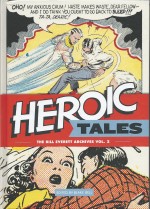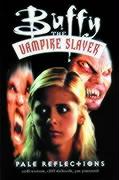
By Steve Ditko & various, edited by Blake Bell (Fantagraphics Books)
ISBN: 978-1-60699-640-9
Perfect Christmas Present Alert! – For every discerning comics fan and suspense lover… 10/10
Once upon a time the short complete tale was the sole staple of the comicbook profession, where the plan was to deliver as much variety as possible to the reader. Sadly that particular discipline is all but lost to us today…
Steve Ditko is one of our industry’s greatest talents and probably America’s least lauded. His fervent desire to just get on with his job and to tell stories the best way he can, whilst the noblest of aspirations, will always be a minor consideration or even stumbling block for the commercial interests which for so long controlled all comics production and still exert an overwhelming influence upon the mainstream bulk of Funnybook output.
Before his time at Marvel, young Steve Ditko perfected his craft creating short stories for a variety of companies and it’s an undeniable joy to be able to look at this work from a such an innocent time when he was just breaking into the industry: tirelessly honing his craft with genre tales for whichever publisher would have him, utterly free from the interference of intrusive editors.
This fourth fantastic full-colour deluxe hardback reprints another heaping helping of his ever more impressive works: all published between July 1957 to March 1959 and all courtesy of the surprisingly liberal (at least in its trust of its employees’ creative instincts) sweat-shop publisher Charlton Comics. Some of the issues here were actually put together under the St. John imprint, but when that company abruptly folded much of its already prepared in-house material – even entire issues – were then purchased and published by clearing-house specialist Charlton with almost no editorial changes.
And whilst we’re being technically accurate it’s also important to note that the eventual publication dates of the stories in this collection don’t have a lot to do with when Ditko crafted these mini-masterpieces: Charlton paid so little the cheap, anthologically astute outfit had no problem in buying material it could leave on a shelf for months – if not years – until the right moment arrived to print…
All the tales and covers reproduced here were created after implementation of the draconian, self-inflicted Comics Code Authority rules (which sanitised the industry following Senate Hearings and a public witch-hunt) and all are wonderfully baroque and bizarre fantasy, suspense or science fiction yarns and helpfully annotated with a purchase number to indicate approximately when they were actually drawn.
Sadly there’s no indication of how many (if any) were actually written by Ditko, but as at the time the astoundingly prolific Joe Gill was churning out hundreds of stories every year for Charlton, he is always everyone’s first guess when trying to attribute script credit…
Following an historically informative Introduction and passionate advocacy by Blake Bell, the evocative tales of mystery and imagination commence with ‘The Menace of the Maple Leaves’, an eerie haunted woods fable from Strange Suspense Stories #33 (August 1957), closely followed a dark and sinister con-game which goes impossibly awry after a wealthy roué consults a supposed mystic to regain his youth and vitality and is treated in ‘The Forbidden Room’ (Mysteries of Unexplored Worlds #4 July 1957)…
From November 1957, Do You Believe in Nightmares? #1 offers a bounty of Ditko delights, beginning with the stunning St. John cover heralding a prophetic ‘Nightmare’, the strange secret of a prognosticating ‘Somnambulist’ and the justice which befell a seasoned criminal in ‘The Strange Silence’: all proving how wry fate intervenes in the lives of mortals. ‘You Can Make Me Fly’ then goes a tad off-topic with a tale of brothers divided by morality and intellect and the issue ends with a dinosaur-packed romp courtesy of ‘The Man Who Crashed into Another Era’…
Next up is a tale from one of Charlton’s earliest star characters. Apparently the title came from a radio show which Charlton licensed, and the lead/host/narrator certainly acted more as voyeur than active participant, speaking “to camera†and asking readers for opinion and judgement as he shared a selection of funny, sad, scary and wondrous human interest yarns all tinged with a hint of the weird and supernatural.
When rendered by Ditko, whose storytelling mastery, page design and full, lavish brushwork were just beginning to come into its mature full range, the Tales of the Mysterious Traveler were esoteric and utterly mesmerising…
From issue #6 (December 1957) ‘Little Girl Lost’ chills spines and tugs heartstrings with the story of a doll that loved its human companion, followed by a paranoid chase from Strange Suspense Stories #35 (December 1957) as ‘There it is Again’ sees a scientist dogged by his most dangerous invention…
Unusual Tales #10 (January 1958) provides a spooky cover before disclosing the awesome secret of ‘The Repair Man from Nowhere’ and, following the wickedly effective Cold War science fiction parable ‘Panic!’ from Strange Suspense Stories #35, resumes with ‘A Strange Kiss’ that draws a mining engineer into a far better world…
Out of This World #6 (November 1957) provides access to ‘The Secret Room’ which forever changed the lives of an aging, destitute couple. Then the cover and original artwork for Out of This World #12 (March 1959) lead to a tale in which a ruthless anthropologist is brought low by ‘A Living Doll’ he’d taken from a native village…
Returning to Tales of the Mysterious Traveler #6 results in three more captivating yarns. ‘When Old Doc Died’ is perhaps the best in this book, displaying wry humour in the history of a country sawbones who was only content when helping others, whilst ‘The Old Fool’ everybody mocked proved to be his village’s greatest friend, and ‘Mister Evriman’ explored the metaphysics of mass TV viewing in a thoroughly chilling manner…
The dangers of science without scruples informed the salutary saga of a new invention in ‘The Edge of Fear’ (Unusual Tales #10, January 1958), after which the cover of This Magazine is Haunted #14 (December 1957) ushers us into cases recounted by the ghoulish Dr. Haunt; specifically a scary precursor to cloning in ‘The Second Self’ and a diagnosis of isolation and mutation which afflicted ‘The Green Man’…
The cover and original art for the giant-sized Out of This World #7 (February 1958) precedes ‘The Most Terrible Fate’ befalling a victim of atomic warfare whilst ‘Cure-All’ detailed a struggle between a country doctor and a sinister machine which healed any ailment.
We return to This Magazine is Haunted #14 wherein Dr. Haunt relates a ghastly monster’s progress ‘From Out of the Depths’ before ‘The Man Who Disappeared’ tells his uncanny story to disbelieving Federal agents, whilst Out of This World #7 provides an ethereal ringside seat from which to view a time traveller’s ‘Journey to Paradise’.
From Tales of the Mysterious Traveler #7 (March 1958), ‘And the Fear Grew’ relates how an Australian rancher fell foul of an insidiously malign but cute-looking critter, after which ‘The Heel and the Healer’ reveals how a snake-oil peddler found a genuine magic cure-all, whilst ‘Never Again’ (Unusual Tales #10 again) took an eons-long look at mankind’s atomic follies and ‘Through the Walls’ (Out of This World #7) saw a decent man framed and imprisoned, only to be saved by the power of astral projection…
Out of This World #12 (March 1959) then declared ‘The World Awaits’ when a scientist uncovered an age-old secret regarding ant mutation and eugenics, Mysteries of Unexplored Worlds #7 (February 1958) exposed ‘The Angry Things’ which haunted a suspiciously inexpensive Italian villa, and the gripping cover to Tales of the Mysterious Traveler #10 (November 1958) segues into the unsuspected sacrifice of a jazz virtuoso who saved the world in ‘Little Boy Blue’…
A tragic orphan found new parents after ‘The Vision Came’ (Tales of the Mysterious Traveler #8, July 1958) and Dr. Haunt proves television to be a cause of great terror in ‘Impossible, But…’ from This Magazine is Haunted volume 2, #16 (May 1958) – an issue which also disclosed the world-changing fate of a soviet scientist who became ‘The Man from Time’…
Another selfless inventor chose to be a ‘Failure’ rather than doom humanity to eternal servitude in a stunning yarn from Strange Suspense Stories #36 (March 1958), whilst the luckiest man alive at last experienced the downside of being ‘Not Normal’ (Tales of the Mysterious Traveler #7) before Unusual Tales #11 – from March 1958 – revealed the secret of Presidential statesmanship to a young politician in ‘Charmed, I’m Sure’, and exposed a magical secret race through an author’s vacation ‘Deep in the Mountains’…
This mesmerising collection then concludes with the suitably bizarre tale of Egyptian lucky charm ‘The Dancing Cat’ (from Strange Suspense Stories #37, July 1958) to ensure the spooky afterglow remains long after the final page and leave you hungry for more mystic merriment and arcane enjoyment…
This sturdily capacious volume has episodes that terrify, amaze, amuse and enthral: utter delights of fantasy fiction with lean, stripped down plots and simple dialogue that let the art set the tone, push the emotions and tell the tale, from times when a story could end sadly as well as happily and only wonderment was on the agenda, hidden or otherwise.
These stories display the sharp wit and contained comedic energy which made so many Spider-Man/J. Jonah Jameson confrontations an unforgettable treat a decade later, and this is another cracking collection not only superb in its own right but as a telling examination into the genius of one of the art-form’s greatest stylists.
This is a book serious comics fans would happily kill or die or be lost in time for…
This edition © 2013 Fantagraphics Books. Introduction © 2013 Blake Bell. All rights reserved.











